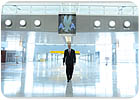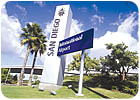
A couple dozen or so U.S. airports are today’s Petri dish for the convergence of information technology and intelligent video. While the Transportation Security Administration (TSA) recently admitted chronic and expensive problems with passenger identification and “watch list” databases, integration of emerging software with captured security video is a working window on the future of fighting everything from terrorism to vandalism.
A TSA grant at Pittsburgh International Airport, for example, supplements security guards and screeners with intelligent video. J. P. Hudson & Associates, based in Beaver, Pa., played a central role in the design and execution of the plan. “We’ve done a lot of work with transportation, with the strongest focus being on airports,” commented John Hudson, the firm’s principal.
To assist in the Pittsburgh International project, Hudson tapped several other security firms including integrator InterTECH Security.
Preprogrammed
The system automatically analyzes the video input, identifying potential security breaches and reacts to suspicious activity with a preprogrammed set of alarm behaviors. “It’s dangerous to get too deep into the details and where we have it deployed, but I think it is safe to say that by using intelligent video technology, the airport is much safer now than it was before,” commented InterTECH’s Christopher Wetzel.According to Austin, Tex.-based GE Security’s Xavier Heusghem, internal and external communications require an efficient audio/visual and data-based information system in order to manage airport security applications, anticipate and make effective decisions and initiate preventative measures for any foreseeable risk. For instance, Toronto’s Lester B. Pearson International Airport uses the firm’s VisioWave solution.
It provides advanced security using distributed system architecture over an IP network, IP-based video surveillance, events/alarms management, integration with other airport security systems while operating on a Gigabit Ethernet and wireless network infrastructure.
In this application, an important aspect of the Toronto system is the ability to offer video services to multiple tenants, who are part of the airport infrastructure, through secured access within the distributed video switching environment.
According to convergence gurus such as Steve Hunt of 4A International, Chicago, (see his column elsewhere in this issue), there are numerous business advantages as security and information technology bridge two worlds.

Business advantages
Steve Rice agrees. An executive at DVTel, Paramus, N.J., he said, “In many organizations, security is now incorporated into the strategy of the company. One catastrophic event could ruin sales and profitability for many quarters to come.” That, of course, includes airports where a major incident could affect the U.S. economy.Added Rice, this new reality is coupled with the tremendous growth of integrated systems and now the convergence of physical security onto company networks. “The immediate outgrowth of new IT-centric security operations has been the sometimes ‘shotgun marriage’ of security and IT. This new relationship is by no means automatic or easy, but it is absolutely critical for organizations to get right.”
He pointed to a major Fortune 500 company, which went with a major security upgrade, choosing network video recorder (NVR) technology for its headquarters and to provide remote access to a number of formally disparate and isolated offices around the world.
That enterprise and many airports share the same next step. Security would have no choice but to work with IT. And it was at this crucial juncture that problems would be created or solutions negotiated that could affect the entire company for years to come.
Here is a thumbnail of Rice’s game plan.
- Identify the right people to work with IT.
- Get clear on the nature of the relationship: Security is now a customer of the IT department, where the department goes to get computers, storage and networking.
- Reach an understanding on both sides about the new roles and relationships. The rules have changed – forever.
- Understand the IT mission. It provides the technology, infrastructure and services in support of their customer’s business requirements.
- Recognize IT’s “pain points,” that is their personnel and resource constraints so as to be set up for success, and not ask for the impossible from the outset.
- Clearly formulate and communicate the security mission to IT, so IT would be able to assist in implementing the security vision.
- Establish a pilot system to monitor network utilization and connectivity to remote offices to proactively address any bandwidth and security issues before putting video on the corporate network.
- Upon selection of technology providers and installers, confirm with IT the understanding of the company’s business requirements and how they will be implemented and achieved in this new world.
Lessons learned
From the security perspective, Rice believes that some of the most important lessons learned in a security-IT include:Moving to a digital solution offers an opportunity to take security from a cost center to contributing to the bottom line. Security must leverage the latest technology to contribute to the company’s profitability.
Security is now seen as part of the business strategy of the company. In this new reality, security must innovate and think outside the box to continue to deliver strategic importance to the company.
To create a mutually beneficial, effective partnership with IT, security must work hard to effectively communicate its business and service level requirements and understand the same from the IT perspective.
Side bar: Intelligent Takeoff at San Diego International
The San Diego Regional Airport Authority, owner and operator of the San Diego International Airport, is moving forward with a $15 million initiative to link the many technologies that control access and perform surveillance in and around the airport. SmartCatch intelligent video surveillance software from Vidient of Sunnyvale, Calif., is potentially a key element of this expanding system.Under the leadership of Mark Denari, director of aviation security and public safety, San Diego is adding intelligent video surveillance to the security measures in place at access points. Currently, there is a beta test in progress at four of these portals, and Denari and his team are working with Vidient engineers to fine-tune the system to recognize the precise behaviors that constitute breach of security policy at the airport.
A prime benefit of intelligent video – video generated by behavior recognition software – is that no one needs to continually monitor the video. When the pre-defined behavior occurs, the recording begins automatically, and alerts are sent to guards or to the individual overseeing the operation when a threat is perceived.
“The Vidient system will tell us when an anomalous event or situation occurs – a breach of our access policies – and will send an alert to our command and control environment. This will draw attention to the event in real time, so we can determine and take appropriate action. We will also be able to review and analyze the digital video historically,” said Denari.
It’s important to distinguish between motion sensor technology and true behavior recognition software. Some motion detector systems create an invisible line in the video – across a secure doorway, for example – and motion across that line, even a bird or wind-blown object, triggers an alert. Sophisticated behavior recognition software available today can recognize a human being, distinguish it from an inanimate object and even accurately determine the number of people in the camera view. Algorithms can be written to spot specific types or sizes of vehicles, packages or pieces of luggage. To use behavior recognition technology, the first step is to identify the precise problem or threat at the location, and then program the software accordingly for that specific video device.
